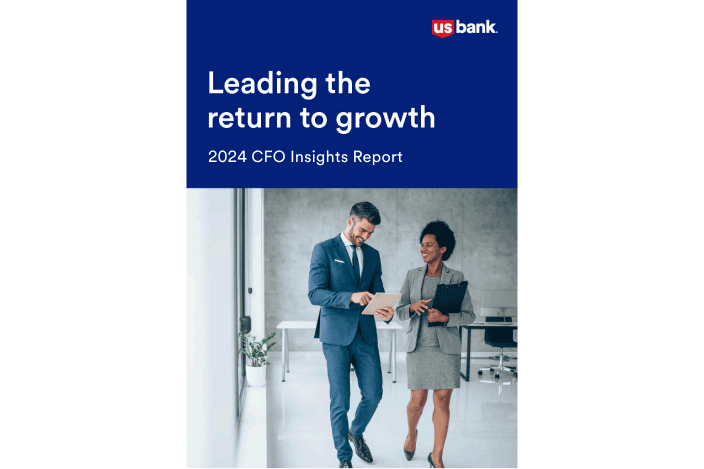Making big decisions in the face of big unknowns
Finance leaders are being pulled in multiple directions. They face tremendous economic and geopolitical uncertainty – not to mention new risks caused by advancing technologies. But they can also see huge growth opportunities for their teams and the wider business.
More Resources
Previous reports
50%
are struggling to balance the need to cut costs with the need to invest in growth.
34%
are exploring emerging technologies, which is up from 27% in 2023.
51%
are prioritizing investing in AI to drive risk management and business growth.
43%
plan to use ERP systems in two years to move money. Only 17% use them today.
Explore what finance teams are doing where you are.
See how finance leaders across the nation are viewing issues like geopolitical risk, cost control, integrated payments and more.
Select a region from the drop-down list to see more region-specific details.
Choose region
There’s a greater focus on costs.
Cost control and driving efficiency in the finance function is still finance leaders’ top priority. As in previous years, finance leaders say investing in new technology is the primary route to delivering savings. This is transforming payment processes with more and more businesses looking to embed digital payments.
Increased business risk prompts action.
Although finance leaders are less likely to be worried about inflation this year, there are growing concerns over geopolitical tension. Some finance leaders aren’t confident that they can manage new threats, but the majority are exploring how AI and financial hedging strategies can help them.
Digital transformation is about to take off.
Finance leaders admit there’s been limited progress on digital transformation in the past 12 months. But that could change soon as finance leaders become more open to exploring emerging technologies. They might also find implementing new technologies is easier as the workforce becomes less resistant to change.
The long-term economic outlook is positive.
The majority of finance leaders are feeling more positive about the next three years than they are about the next 12 months. This is true for both the U.S. economy and for the financial prospects of their own businesses.
Interest in payments transformation surges
Risk mitigation, automation and improving customer experience have become the top three drivers of payments transformation. This is propelling adoption of digital payments, led by instant payments, with 51% currently using instant payments through the RTP® network and FedNow® Service and 80% planning to in two years.

Embedding payments in fintech and ERP systems is expected to grow.
Increasing adoption of digital payments is inspiring businesses to consider opportunities to embed payments into their existing systems. Over the next two years, interest in moving money within fintech and ERP systems is doubling. This increased motivation is driven largely by the desire to enhance customer experiences with the specialized capabilities offered by fintech platforms, as well as the opportunity to gain operational efficiencies by embedding payments into existing workflows.

Read our 2024 CFO Insights Report.
Find out how the finance function is mastering the balance of offense and defense by focusing on cost control, risk mitigation, digital transformation and embedded payments.
Are finance teams ready to think more long-term?
As they balance short- and long-term goals, finance teams will need to do more.
For the third year running, finance leaders say talent shortages are their top business risk, and digital disruption is second. They’re far more willing now to experiment with new technology and innovative payment systems, but progress on digital transformation in the past year has been limited.
To overcome these challenges, CFOs need to strike a delicate balance between defensive and offensive strategies. They must control costs while investing in new technology, mitigate risks while striving to improve customer experiences, and restructure the workforce while nurturing talent.
They must lead the return to growth.
41% say a shortage of talent is the number one risk facing their business.
45% say they're struggling to balance the short- and long-term needs of the business.
About the research
These results come from a survey of 2,030 senior finance leaders working in U.S. businesses. This year’s research follows “Leading the transformation,” our 2023 survey of 1,420 finance leaders. The previous edition of the research, “Leading through uncertainty,” was released in 2022. The first edition of the research, “Leading the recovery,” was released in 2021.
Job Roles
Company sizes
Every survey respondent works for an organization that generates at least $100 million in annual revenue. This is the percentage of respondents by annual revenue:
- >$5 billion: 10%
- $2 – 4.99 billion: 20%
- $500 million – 19.9 million: 30%
- $100 – 449 million: 40%
By obtaining responses from finance leaders across a wide range of sectors, company sizes and job roles, we are able to provide a report that incorporates a wide range of viewpoints.
Access the 2024 CFO Insights Report.
This year’s CFO Insights Report offers unique and valuable perspective from senior finance leaders across industries and across the nation. Please complete the form below to receive your PDF copy of the report.

